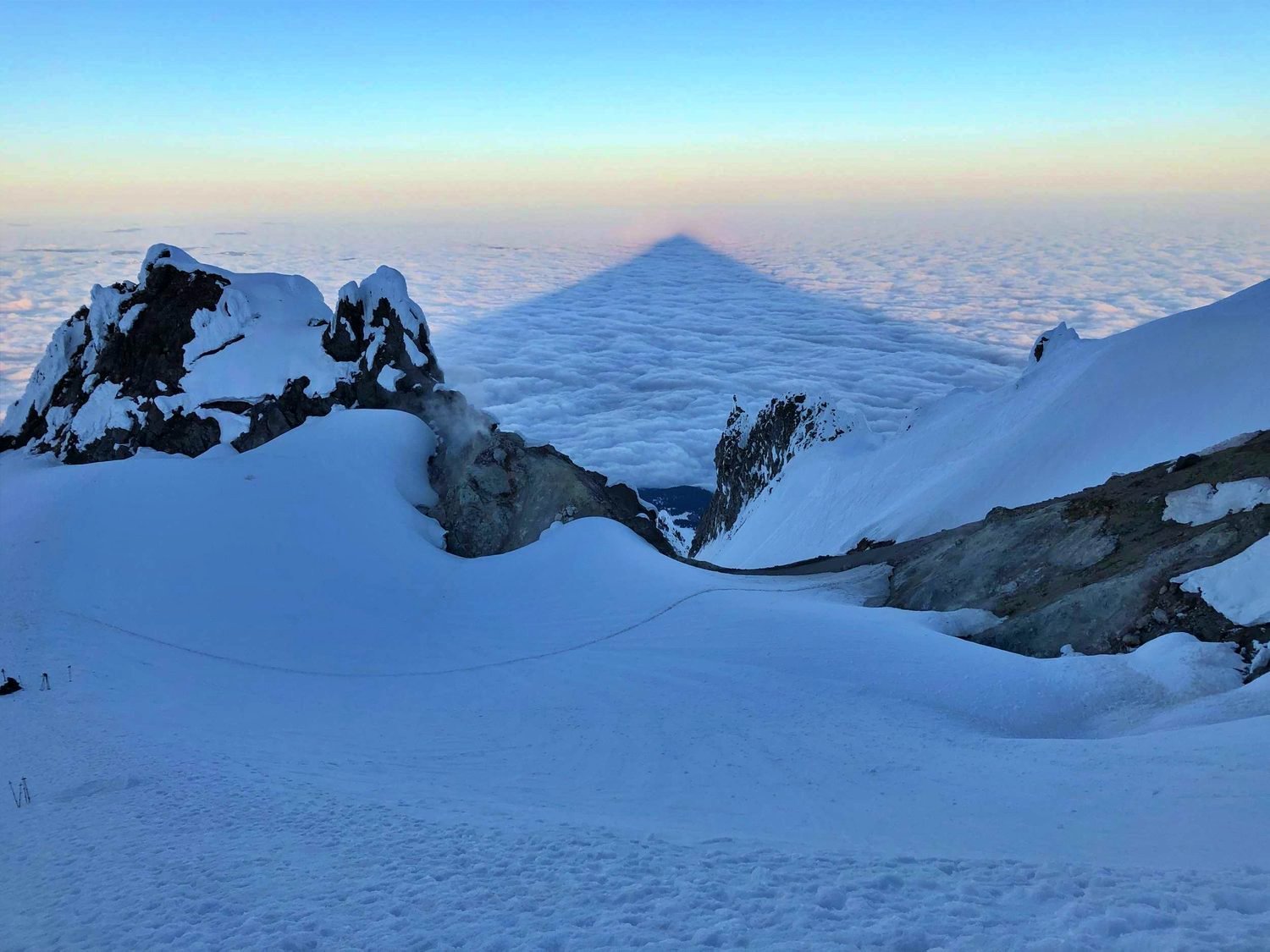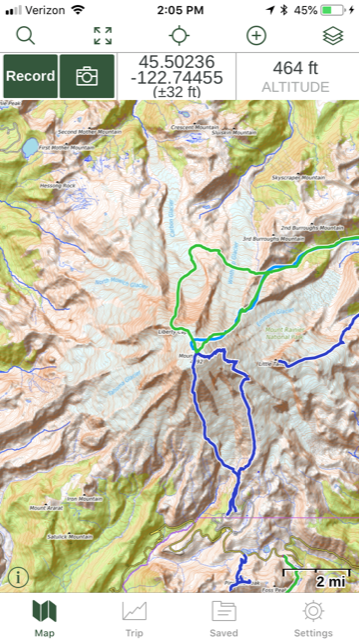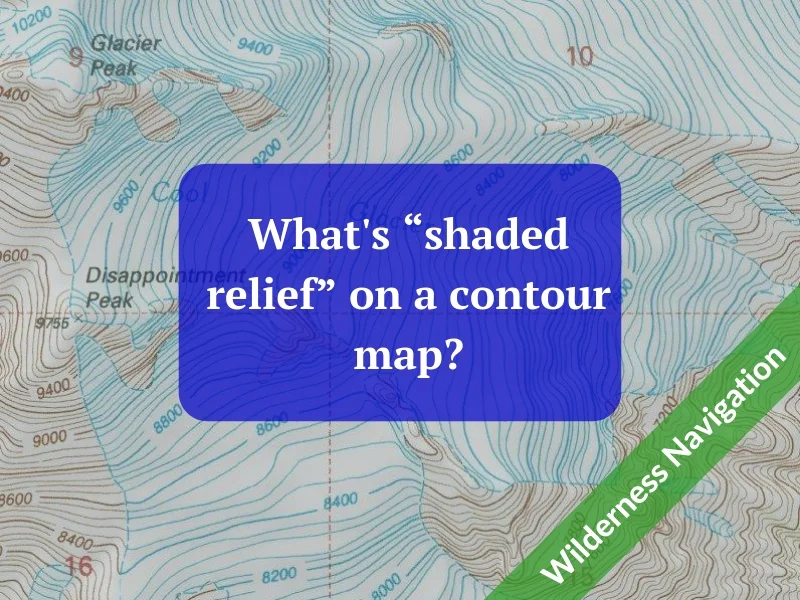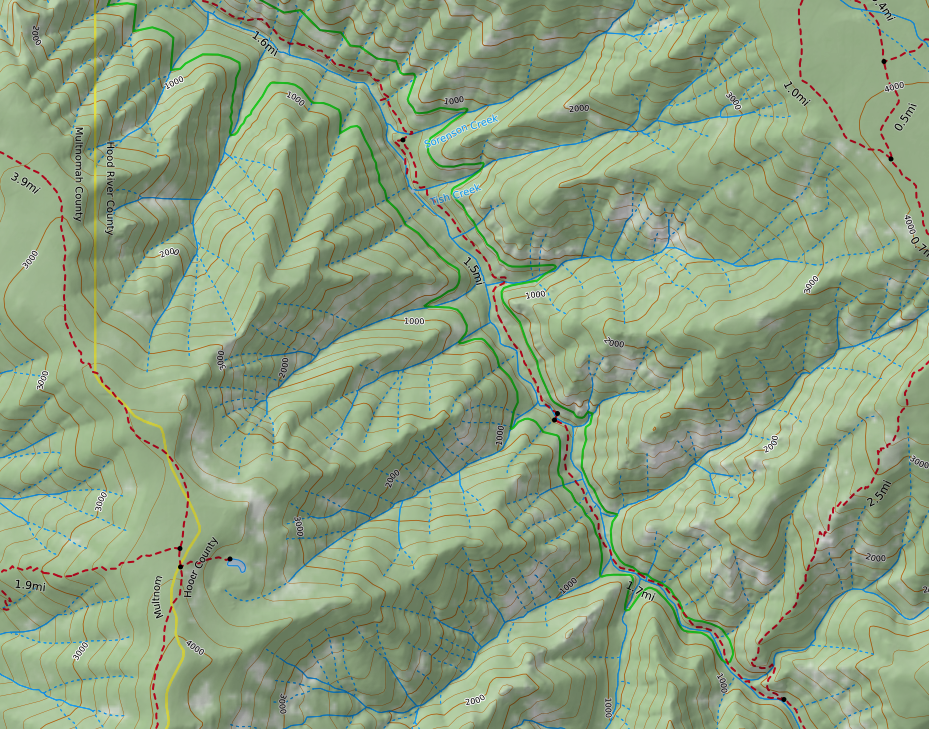
Alpine Tips
CalTopo tip - Try the "MapBuilder Topo" layer
Caltopo has one map base layer that’s a superb choice for most any backcountry adventure - MapBuilder Topo. See a side-by-side comparison of the old-school USGS map.
If you're new to using CalTopo mapping software, watch this tutorial to get started.
CalTopo, in my opinion the best online and free mapping software, continually rolls out great new features. There’s a (relatively) new map layer, called "MapBuilder Topo” that is a terrific option for printing outdoor recreation maps. It's a big improvement over the standard USGS 7.5 minute map layer.
What’s cool about it?
Shaded relief (shows terrain features like ridges and gullies more clearly)
Easy to see and well-labeled contour intervals
Roads and trails easily visible and labeled
Some distracting non-essential map information (such as unnecessary text, public lands survey section lines and wilderness boundaries) removed or made less prominent
County lines added in yellow (it’s helpful to know what county you‘re in if a rescue is needed)
Shows approximate vegetation and terrain boundaries, such as forest, rock, and snow/glacier, even crevasses
Have a look yourself!
Go to caltopo.com
Mouseover the “Base Layer” icon in the top right corner
Select "MapBuilder Topo” from the drop down menu (should be the first choice at the top)
Zoom in to your area of interest. Swap back and forth between this map layer and USGS to see the differences. (Note that the map tiles may take longer to generate on your computer and also to print when using this layer.)
Here’s an example of Mt. Hood south side in the standard, old-school US Geological Survey 7.5 minute topo map.
Note that there’s no relief shading, trails are hard to spot, there’s unnecessary “Mount Hood” text in a large font, the chairlift isn’t shown. Not bad, but definitely room for improvement.
Now, here’s the same map area in the MapBuilder Topo layer. Improvements:
the relief shading makes the gullies and ridges much more obvious
county line (yellow) is labeled
ski chairlift is shown (very handy for finding your way back down in low visibility)
trails are clearly delineated and labeled
every index contour has an elevation label
green wilderness area boundary is current and correct
Which map would you rather use? The USGS 7 1/2 minute maps for many decades were the only game in town, and unfortunately that’s what some old-school navigation classes and textbooks still advise you to use. But, for most people and most activities, these are no longer the best choice.
Get with the modern times, learn to use mapping tools like CalTopo, and you can have a superior map for free!
And, if you think CalTopo is great, I strongly encourage you to support CalTopo with a $20 annual subscription. There is just one guy running this entire software platform, and your modest annual subscription can help ensure that this great service continues on into the future.
Having a subscription also gives you some nice perks, like being able to print on larger size paper, and being able to save and share your maps to the cloud. When you consider that a single commercial map of just one area can cost between $10 and $15 at the outdoor store, a $20 annual subscription to this mapping software is a pretty screaming deal.
Need to learn the basics of CalTopo? My tutorial video will get you started.
Add custom map layers to GaiaGPS
Gaia GPS is a great navigation app for your smartphone, with loads of map layers to choose from. Even so, you may want to access ones they don't have, such as Google Earth satellite imagery or Open Topo. Adding a custom map layer is easy once you know how.
Gaia GPS is regarded as one of the best backcountry GPS apps for your smartphone. They offer a wide variety of base maps to choose from, but one of my personal favorites, called Open Topo, happens to not be one of them.
What makes Open Topo a terrific choice for outdoor adventures? It has nice shaded relief (which makes features like ridges and gullies much easier to see), updated trails and roads, and land cover, such as forest, rock, or snow. (One potential curveball for Americanos - elevations and contours are in meters.)
Go have a look yourself. Go to opentopomap.org and zoom into your favorite part of the world.
Here’s a screengrab of Mount Rainier in Open Topo. Pretty cool, eh? Like I said, elevations are in meters.
The one small downside is that it is not part of the Gaia GPS app.
The good news is, with a little computer sorcery, you can add this as a custom map layer to your Gaia GPS phone app. Here's how to do it.
These steps might sound a little complicated, but it's pretty straightforward. Keep this webpage open in a browser tab so you have a reference.
Here's a nice video that shows how to do it, using Google Earth.
Here are the step-by-step instructions, for a different map source as mentioned above, Open Topo.
1. On a desktop computer (not your phone), go to GaiaGPS.com. Log in to your account, or create an account if you don’t have one.
2. Click your user name (top right of screen), and from the drop down box select "Map Sources".
3. Click "Import an External Map Source".
4. In the “Name the Map” box, give it a name. I suggest a simple, descriptive, name, like “Open Topo custom“.
5. Scroll a bit lower, locate "Paste your modified link here"
6. Copy and paste this link in that box:
https://c.tile.opentopomap.org/{z}/{x}/{y}.png
7. Scroll to the bottom, click "Add this Map Source"
Go to your phone.
8. Make sure you are signed in to your Gaia account on your phone. [Settings icon > Account > Login) and that “Sync/Backup” is toggled on.
9. Restart the app.
10. Tap the Map Sources icon, top right of your screen. Tap Edit, then scroll to the bottom and tap “Custom Imports”.
11. You should see “Open Topo Custom” here, or whatever you decided to name it. Select this map layer to add it to your viewable layers. You should now be able to use Open Topo on your phone.
Below is a phone screengrab of Mt. Rainier in Gaia GPS Open Topo map layer, with climbing GPX tracks in blue and green.
Suunto compasses - 3 options for wilderness navigation
There are lots of options for compasses. Let’s make it easy - here’s 3 recommended models from Suunto that should cover the needs of every backcountry traveller.
Suunto, a Finnish company with a great track record of quality compasses, makes a variety of models. Here's an overview of three that should suit the needs of most outdoor travelers.
Generally speaking, it's best to choose a compass that has adjustable declination, which I think is the most important feature. Having adjustable declination let you measure bearings to true north, and thus eliminates any confusing backcountry arithmetic such as adding or subtracting declination.
Having said that, I realize that a compass a piece of gear that some people will rarely use and want to save a few bucks on. So. I'm going to suggest three different price points, think of it as good, better, best, so you can choose the one that looks best for you.
(Note that Alpinesavvy does not have any affiliate marketing links, so I make nothing from the Amazon links below. I include them more as a convenience for you.)
Before we get to the recommended compasses, here are two that I do not recommend. Students often show up with these in me navigation classes, but if you're shopping for your first one, please give these a pass.
The Brunton compass on the left is part of the “TruArc” series. They are unfortunately carried by REI, so a lot of people (unfortunately) buy them there. The problem with these is that the declination adjustment is very difficult to do. They have lots of lousy reviews, and I feel you would do better to buy a Suunto, as recommended below.
The rather strange looking green one on the right is a military style “lensatic” compass. It can be very accurate once you know how to use it, and it's probably good for calling in artillery strikes, But it lacks a lot of the features that civilian users need, so for most people it's not recommended.
Good - Suunto A-10 compass
This is a bare-bones compass, but still a quality instrument. It has what is called “fixed declination”, not adjustable declination. But, everything else about it is solid, including the nice curved base plate which ergonomically fits in your hand, always reminding you of the proper way to hold the compass.
Here’s a trick to deal deal with magnetic declination on this compass (or any other similar baseplate compass this does not have adjustable declination). Carefully draw a line with a medium black sharpie pen from the center of the compass to your local declination on the outer dial. Now, when you want to take a bearing or measure a bearing, you line up the red magnetic needle on this pen mark, and not the red orienteering arrow. Of course, this only works if you stay in your local area. If you travel far away where the declination might be different, you may have to erase this pen mark with a little rubbing alcohol or nail polish remover or some other solvent, and draw again. But, it's one option for the frugal climber.
Cost: about $16 (Oct 2018)
Suunto A-10 compass
Better - Suunto M3 compass
The Suunto M3 is my personal favorite, which hits the sweet spot between having all the features you need, and none of the ones you don’t.
Here’s what I like about it:
adjustable declination
long baseplate (for taking accurate measurements from a map and drawing bearings on a map, a long baseplate is helpful)
ergonomic design (the curved part fits your hand, eliminating the common mistake of having the “direction of travel” arrow pointing at you rather than your objective)
low cost (about $15 less expensive than a comparable compass with a sighting mirror)
simple and sturdy (fewer moving parts and hinges mean fewer things that can go wrong in the field)
lightweight (no sighting mirror means less weight)
A few words on sighting mirrors . . .
But what about compasses with a sighting mirror, you may wonder. Don’t offer greater precision when taking a bearing? The short answer: Yes, they do, but for almost all backcountry uses of a compass, you don’t need this level of precision. If you’re doing field mapping or walking a straight line when on a search and rescue team, then the slight increased precision of a mirrored compass might be justified. But for the vast majority of the simpler backcountry uses of a compass, like taking a bearing to an object and then either following it or plotting the bearing on a map, the +/- 2 degrees of accuracy you can get with baseplate compass works just fine.
Also, consider that a mirror compass LACKS most of the good qualities listed above.
Most mirrored compasses:
are not ergonomically designed
are expensive
are heavy
have more moving parts that can break
I have used my Suunto M3 compass to take a bearing from a map, follow that bearing cross country for more than a mile, and hit my precise objective . . . at night. With a little practice, you can too. Don’t throw away your mirror compass if you already have one and like it, but if you are looking for a compass to buy, the Suunto M3 or similar model is a better choice for most users.
Cost: about $30 (Oct 2018)
Suunto M3 compass
Best - Suunto MC-2
I know that some people will want a compass with a sighting mirror and possibly a clinometer. Both of these features are found on the Suunto MC-2, which is the next model up from the M3 in terms of the whistles and bells. This costs about $40-$45. Again, I feel this model is not necessary for the majority of users, but if you want these extra features, this compass is a great choice.
Cost: about $45 (Oct 2018)
Suunto MC-2 compass
Are you more likely to get lost going up or going down?
Are you more likely to get lost when you are climbing up a mountain, or heading down?
Quick question: Are you more likely to get lost going up a mountain, or on your way down?
Answer is: going down. This is true for several reasons.
Terrain features like ridges and gullies diverge you go downhill away from a summit, magnifying the mistake of choosing the wrong feature.
On the way down, you’re physically and mentally more tired, so you're more prone to navigation errors.
Returning to your last known point (usually the best way of getting unlost) usually involves going back uphill, which sucks. It's easier to keep going down, which can turn slightly lost into completely lost.
What's “shaded relief” on a contour map?
“Shaded relief” is a bit of cartographic wizardry that tricks your eye and brain into seeing the landscape in almost 3-D. It makes seeing terrain features like ridges and gullies much easier than with a standard topographic map. It's quick and free to print your own shaded relief maps with Caltopo.
Shaded relief, also known as terrain shading, is a very clever way to make contour maps appear more three dimensional. With shaded relief, terrain features such as ridges and gullies appear much more prominent and recognizable. The shading works some magic between your eye and your brain to make what you're looking at appear 3D. It's really quite amazing!
Below is an example of the Eagle Creek Trail in the Columbia River Gorge in Oregon. (The red line is the wilderness boundary.) This first map is from the standard USGS 7 1/2 minute topographic map, with no shaded relief. At first glance, most people will see this as pretty much a spaghetti pile, with no obvious ridges or gullies visually jumping out. (Yes, if you know a bit about reading contours you can probably make out some of the terrain features, but that’s a different topic.)
Now, here’s a screen grab of the exact same area, with about 20% shading added to the map.
Magic! Notice how the ridgelines and the stream drainages are much more obvious? Most people find this map MUCH easier to read.
Before modern mapping software, cartographers tried to achieve this by using hand drawn shading. This was incredibly labor-intensive, but achieved some beautiful examples of cartographic art. Here's an example of some amazing Swiss hand drawn relief shading, near Mount Everest.
Fortunately, mapping software today makes it easy to add with just a few clicks. Many commercially produced maps have some sort of terrain shading added, but it’s also easy to make your own maps for free that have this helpful feature.
Probably the easiest way is to use the terrific mapping software Caltopo. In Caltopo, a fast way to get terrain shading is to choose the map base layer called MapBuilder Topo, from the top right menu. This map layer is a great choice for any sort of outdoor recreation, as it has updated roads and trails, a little bit of vegetation shading, and terrain shading.
Learn to easily make your own maps like this with Caltopo from this YouTube video.
Here's an example of the same Eagle Creek area, made in CalTopo with the MapBuilder Topo layer. Note that the distracting red wilderness area boundary is now easy-on-the eyes green, and the red-dashed line trails are much easier to see.
Finally, let’s look at the old school USGS topo map one more time. Ask yourself - which map would you rather use? The answer should be pretty obvious.
Don’t use your compass in a car
A large metal object, like your car, and the delicate magnetic needle of your base plate compass, do not play well together. Read this cautionary tale.
It was about 10 years back, and I was driving some boondock road in Central Oregon.
I was on a dirt road that seemed to be running directly north south, but I was feeling a bit turned around. So I stopped the car and got out my trusty Suunto M3 baseplate compass, to make sure I was driving in the intended direction.
Sitting behind the wheel, I pointed my compass straight ahead, spun the dial to put red in the shed and . . . The compass indicated that the road was heading pretty much east/west! Very puzzling!
Then I had an idea. I got out of the car, walked to the other side of the road, and once again took a bearing on the road in front of me. The compass now showed the road running exactly north south, just like I thought. Keeping a close eye on my compass needle, I walked back toward my car. When I got a few feet away, sure enough, the needle started slowly moving randomly. As I walked around the car with compass in hand, that large block of metal continued twitching my compass needle.
So, here’s The Takeaway. Don’t use a baseplate compass intended for backcountry navigation inside or nearby your car or any other large metal object. (Compasses that come built into the car, such is the one that might be on your rearview mirror, are already calibrated by the clever Car Engineering Gnomes to be correct.)
And, related to this, avoid using the hood of your car as a place to lay out your maps, take bearings, and in general do any kind of work with your compass. It’s usually is the largest, flattest and most convenient place to look at a map. But as you now know, trying to do anything that involves the magnetic needle of your compass on the hood of your car is a Bad Idea.
What are some other metal objects that can interfere with your compass?
electric power lines
belt buckles
zippers
most any sort of electronics, especially cell phones and avalanche transceivers
Try this: Put your mobile phone flat on the table, and move your compass slowly toward it, especially near the bottom (speaker part) of the phone. You should see the compass needle swing dramatically.
Most common way to get lost in the Columbia River Gorge
People can get lost for any number of reasons, but there is one common factor in most “lost hiker” stories in the Columbia River Gorge. What do you think is the number one cause?
Quick, what situation do you think is responsible for more people getting lost in the Gorge than any other? (and the same probably holds true for many other parts of the world as well.)
Picture this scenario. It’s early April, you’ve felt stuck indoors after a long soggy Northwest winter, there’s a weekend forecast of clear sky, and you’re busting to get outside. You head out to the Gorge to try a tough trail that goes up approximately 3,000 feet to the plateaus of the Oregon side. You've hiked the trail a few years ago, but you don't quite remember where it goes.
No problem for the first 2,000 feet or so. The trail is obvious, and you’re feeling strong. But, as you continue to climb, snow patches appear, start getting thicker, and then your trail completely disappears under the snow.
Here’s your answer. Continuing on a trail that becomes covered with snow is the number one way people get lost in the Gorge.
If the trail you're on becomes snow-covered, it’s a great time to take a break and reassess your objective for the day.
How familiar are you with the rest of the trail?
Are you doing an up and back hike on the same route, or a loop that comes down a different way? (On an out and back, at least you can maybe retrace your footsteps.)
Do you have a solid GPS track on your phone GPS app or GPS receiver that you can follow, even if the trail becomes snow-covered?
The takeaway: When going on a hike where you anticipate snow at higher elevations, always be sure of your route, use a GPS track if you have it, and definitely consider turning around if the trail you were relying on is no longer visible.
(This tip was shared with me a while back from a Search and Rescue team member from Hood River. Now, I’m not sure if this is statistically accurate or not, as it only comes from this one source, but it is still a good cautionary tale.)
























